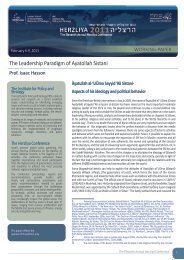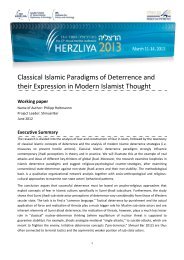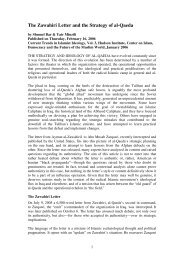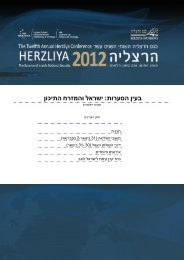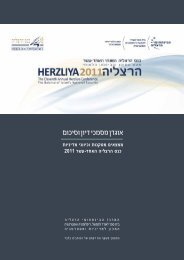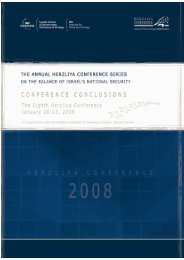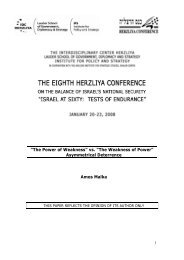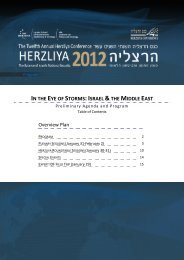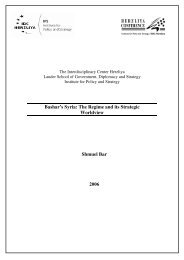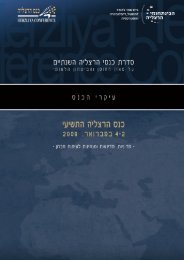Iran: Cultural Values, Self images and Negotiation Behavior
Iran: Cultural Values, Self images and Negotiation Behavior
Iran: Cultural Values, Self images and Negotiation Behavior
Create successful ePaper yourself
Turn your PDF publications into a flip-book with our unique Google optimized e-Paper software.
Individualism<strong>Iran</strong>: <strong>Cultural</strong> <strong>Values</strong>, <strong>Self</strong>-<strong>images</strong> <strong>and</strong> Negotiating <strong>Behavior</strong>Individualism is the most prominent trait usually associated with <strong>Iran</strong>ians, both by<strong>Iran</strong>ians themselves <strong>and</strong> by foreigners. One expression of this trait is the ease withwhich <strong>Iran</strong>ians tend to adapt abroad, even without a supportive <strong>Iran</strong>ian community. 30The typical <strong>Iran</strong>ian is described as resourceful, clever, <strong>and</strong> capable of overcomingoverwhelming odds in order to extricate himself from seemingly hopeless situations.Whether or not this is typical, all these traits, as we shall see below, are perceived by<strong>Iran</strong>ians as such – <strong>and</strong> more significantly – as social behavior which is worthy, <strong>and</strong>hence to be encouraged.Some observers of <strong>Iran</strong>ian culture have described the <strong>Iran</strong>ian proclivity towardsindividualism as the result of geographic conditions, 31 modalities of family life, 32 orthe despotic structure of all the political regimes that have been in power in <strong>Iran</strong>,forcing the individual to fend for himself <strong>and</strong> his family <strong>and</strong> not to trust anyoneoutside of his intimate circle. 33 It has also been attributed to the centuries of invasion,foreign domination, <strong>and</strong> anarchy 34 that atomized <strong>Iran</strong>ian society <strong>and</strong> created a culturalethos which favors the individual who proves his ability to best fend for himself <strong>and</strong>protect his close kin. 35Observers who have delved into this trait have linked it to a preference for family,local <strong>and</strong> regional identity, <strong>and</strong> cohesiveness, at the expense of national interests(“local <strong>and</strong> regional individualism”) 36 . One approach differentiates Persianindividualism from its Western counterpart in that the former “lacks an emphasis onetc.). Frequently, the <strong>Iran</strong>ian would take the money <strong>and</strong> use part of it to pay off opposition figures inthe area where the transaction was to take place to attack him for his support of the British. Then hewould come back to the British <strong>and</strong> report that he could not deliver because the leaks (of course fromthe British side) precluded it (Private communication).29 An example given is the modus oper<strong>and</strong>i of Rafsanjani, who is seen as the consummate BazaariMachiavellian. It is said that he intentionally spread rumors that Khamene'i was about to nominateAyatollah Shahroudi as his successor. These rumors caused a furor due to the fact that Shahroudi isseen as an Iraqi (who does not even speak Persian well). The rumors embarrassed Khamene'i in hispower base of Qom <strong>and</strong> strengthened Rafsanjani by "clipping the wings" of Shahroudi <strong>and</strong> enhancingthe Rahbar's dependence on him. Another story imputes to Rafsanjani hiring of a thug to attack hisdaughter during the election campaign in order to create sympathy for her <strong>and</strong> to guarantee herelection. Whether the story is true or not, it expresses the level of Machiavellianism that is attributed tothe political leadership.30 Lt. Col. Sir Arnold T. Wilson, “National <strong>and</strong> Racial Characteristics of the Persian Nation,” AsiaticReview XXV.82 Apr. 1929: 300-311, 301.31 Millspaugh 77. An agricultural economy based on subsistence farming with units of cultivationremote from each other gave birth to a “self-centered individualism… scarcely conscious of any largercommunity except to distrust <strong>and</strong> fear it.”32 See Gable, Culture <strong>and</strong> Administration in <strong>Iran</strong>, 416.33 Haas <strong>Iran</strong>, 118; Richard W. Gable, “Culture <strong>and</strong> Administration in <strong>Iran</strong>,” Middle East Journal, XI1959 416-417 attributes <strong>Iran</strong>ian individualism to the influence of family life which places theindividual, socially, in a limited context of the family alone. Outside the family he lacks a social frameof reference34 See Reza Benham, <strong>Cultural</strong> Foundations of <strong>Iran</strong>ian Politics, 98-99: “Unstable administration in<strong>Iran</strong>ian society over the years seems to have encouraged a strong sense of individualism in terms ofpersonal, community, <strong>and</strong> regional loyalties since <strong>Iran</strong>ians were left to fend for themselves… Theindividualism that has characterized <strong>Iran</strong>ians is unlike that known to developed societies…[it] has beenmarked by distrust based on the assumption that all people are in pursuit of personal interests.” AlsoAli Banuazizi, <strong>Iran</strong>ian "National Character": A Critique of Some Western Perspectives, 224.35 Haas 118; Gable 407–521; Millspaugh 77.36 Haas, <strong>Iran</strong> 118.10



